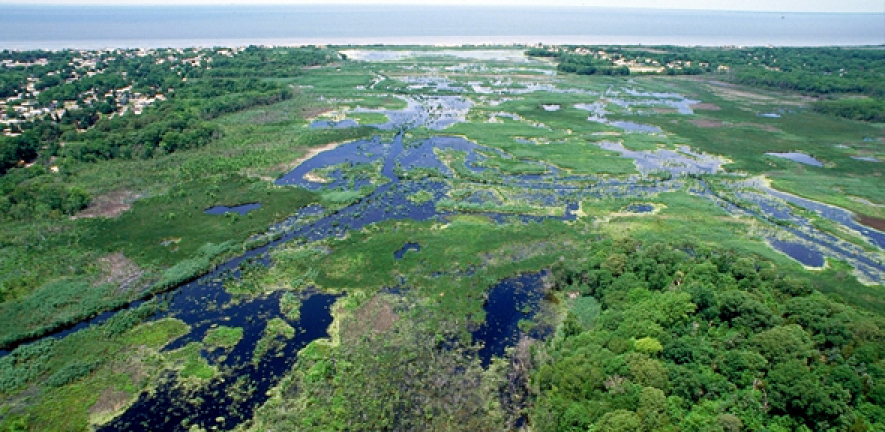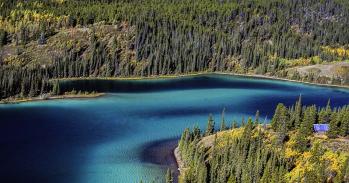
Researchers have modelled how wetlands might respond to rising sea levels, and found that as much as four-fifths of wetlands worldwide could be lost by the end of the century if sea levels continue to rise.
Researchers have modelled how wetlands might respond to rising sea levels, and found that as much as four-fifths of wetlands worldwide could be lost by the end of the century if sea levels continue to rise.
We need integrated management of wetlands and coastal protections on a national and international scale.
Tom Spencer
Using a new model to measure the possible effects on wetlands on a global scale, the researchers, from the UK and Germany, modelled the impacts of different scenarios for sea level rise to the end of this century.
They found that even in the event of ‘low’ global sea level rise (around 30 centimetres), much of the world’s wetlands, particularly on ‘micro-tidal’ coasts, are vulnerable. Around 70 percent of the world’s wetlands are found on micro-tidal coasts, where the range between high spring tide and low spring tide is less than two metres, such as in the Mediterranean and the Gulf of Mexico. The results are reported in the journal Global and Planetary Change.
Across the globe, wetlands cover more than 750,000 square kilometres, an area more than three times the size of the UK. Coastal wetlands, which include salt marshes, mangrove forests and mud flats, protect against erosion and flooding, provide habitat and food for wildlife, improve water quality, support commercial fisheries, and can store large amounts of carbon.
“Wetlands are particularly sensitive to environmental change, and are being lost worldwide due to human activity, such as conversion to agriculture, and through the effects of climate change, including rising sea levels,” said Dr Tom Spencer of the University of Cambridge’s Department of Geography, the paper’s lead author.
According to the Intergovernmental Panel on Climate Change (IPCC), it is very likely that sea levels will rise during the 21st century, but by how much depends on a variety of factors, including thermal expansion caused by ocean warming, loss of ice in glaciers and ice sheets, and the reduction of liquid water storage on land.
The Wetland Global Extent Index, published in 2014, estimates that between 1970 and 2008, natural coastal wetlands declined by nearly 50 percent. A main reason for the high vulnerability of coastal wetlands to sea level rise is coastal ‘squeeze’, a consequence of long-term coastal protection strategies, such as dikes. While dikes provide flood defence to coastal populations and infrastructure, they prevent wetlands from moving landwards and upwards: dikes leave them with nowhere to go.
Wetlands such as salt marshes are made up of grasses and shrubs and are sensitive to environmental change, whereas wetlands such as mangrove forests, since they are trees, are far more resilient, at least in the short term.
Previous attempts to quantify the risk to wetlands posed by rising sea levels have focused on small areas, or have only looked at wetlands being lost through ‘drowning’ of the plants and shrubs, and not at how wetlands will ‘migrate’ inland.
The model that Spencer and his collaborators from the University of Southampton and Middlesex University in the UK, and the Geographisches Institut and the Global Climate Forum in Germany, have developed assesses biophysical and socio-economic consequences of sea level rise and socio-economic development, taking into account coastal erosion, coastal flooding, wetland change and salinity intrusion.
The researchers used their model to look at three different sea level rise scenarios (low, medium and high), combined with different scenarios for dike construction (no dikes, widespread dikes and maximum dikes), and assessed what the effect on coastal wetlands would be for each.
They found that if global sea levels rise by 100 centimetres combined with maximum dike construction, global wetland losses may reach 78 percent. For a rise of 50 centimetres, between 46 and 59 percent of coastal wetlands could be lost. For sea level rise around 30 centimetres, wetlands in micro-tidal regions are the most vulnerable.
“What our model does is provide better-informed projections about what might happen to wetlands over the coming century on a global scale,” said Spencer.
One of the issues which the researchers looked at was the use of dikes, seawalls, levees and other forms of coastal protection, and finding the balance between protecting cities and infrastructure from flooding, and protecting the wetlands which also play a key role in flood defences.
“One of the key things this project shows is that we need integrated management of wetlands and coastal protections on a national and international scale,” said Spencer. “Because if you don’t, in many cases if you protect one section of the coast, all you’re doing is moving the problem somewhere else.”
Countering these potential wetland losses will require both global responses such as climate mitigation to minimise sea level rise, and regional responses such as the maximisation of accommodation space and sediment supply on low-lying coasts.
The researchers have already begun working on the next version of their model, which will also consider the effect that storms have on wetlands.
The research was supported in part by the European Union.
Reference:
Thomas Spencer et. al. ‘Global coastal wetland change under sea-level rise and related stresses: The DIVA Wetland Change Model.’ Global and Planetary Change (2016). DOI: 10.1016/j.gloplacha.2015.12.018

The text in this work is licensed under a Creative Commons Attribution 4.0 International License. For image use please see separate credits above.




